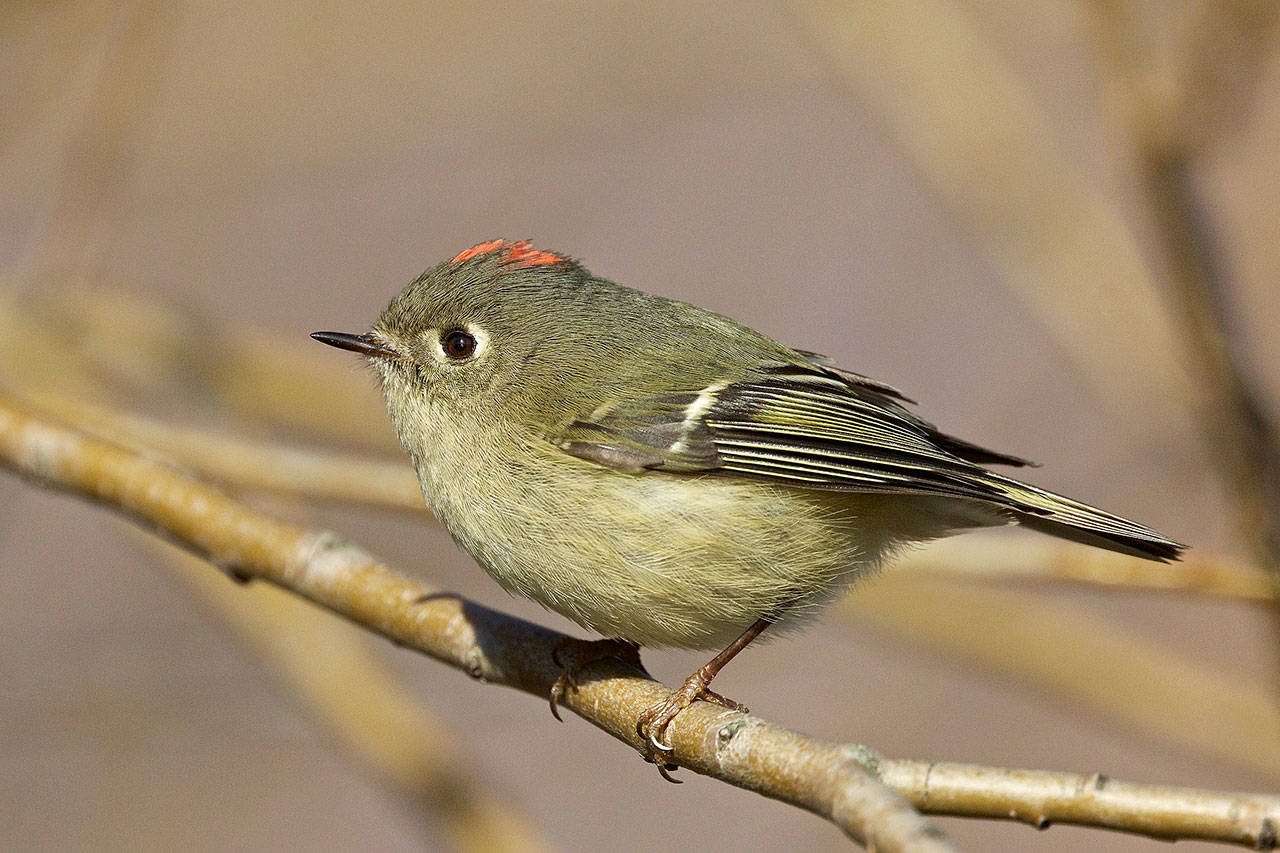This is a bird that takes some careful searching and listening to both find and identify. It drives photographers crazy because they may be able to hear it (very high-pitched and difficult to hear if you have aging ears as I do) but it makes you work to find it. Gregg Thompson’s photograph shows one of them in fine detail, a male with some of his red crown showing.
General description: Ruby-crowned Kinglets are very small and extremely active birds. Both sexes are approximately 3.5 to 4.3 inches in length, with a wing span of 6.3 to 7.1 inches, and they weigh about 0.2 to 0.3 ounces. Their overall appearance is pretty non-descript, a sort of olive-green with a prominent white eye-ring and white wingbar, with a black patch below (a distinguishing feature to correctly I.D. the bird) and then there is that single line of vivid red feathers on the crown that is only seen when the bird is excited. Females lack the crown. Like most bug-eaters, the bill is short and sharply pointed.
Habitat: During migration and in the winter these birds can be found in shrubby habitats, deciduous forests, parks, and suburbs. Their breeding territories are higher elevation forests of spruce, fir, and tamarack, or pockets of small openings within the forest.
Behavior: One of the distinguishing characteristics of this bird is the way it constantly flicks its wings, like a nervous twitch. They can be found in mixed-species feeding flocks, often with their “cousin”, the Golden-crowned Kinglet…though the number of Golden-crowned Kinglets is larger than the Ruby-crowned. Also, while the Golden-crowned Kinglet often hangs upside down while gleaning insects from leaves and twigs, the Ruby-crowned Kinglet more often hovers in front of the leaf or under it to catch prey. They also fly out from branches to grab insects out of the air. They are more often found lower in the bushes and trees than the Golden-crowned Kinglet.
Diet: Ruby-crowned Kinglets eat tiny insects, spiders, and eggs, especially eggs that are stuck to the undersides of leaves and twigs. In winter they also eat some seeds, sap, and berries, including poison-oak berries and the pulp of dogwood berries.
Nesting: Ruby-crowned Kinglets are monogamous but form new pair bonds for each breeding season. The female chooses the nest site near the trunk of a tree or hang suspended beneath two twigs and protected from predators and the elements by overhanging branches. The nest is usually in a conifer 40 or more feet from the ground, takes about 5 days to build, and is comprised of moss, grass, lichen, bark strips, twigs, rootlets, needles, and spider webs for its outer walls, and feathers, plant down, and hair forming a soft lining. These birds lay a whopping 9 to 10 eggs, sometimes as many as 12! The female incubates the eggs for two weeks while the male brings food to her on the nest. She broods the young for a few days then joins the male in bringing food to the nest for the young. The young leave the nest about 16 days after hatching while the male continues to feed them for another 10 days. Meanwhile, the female leaves the breeding territory. They only produce one brood per year.
Migration: Ruby-crowned Kinglets migrate slightly earlier in the fall and later in the spring than Golden-crowned Kinglets. They are less well adapted to cold and thus winter farther south than Golden-crowned Kinglets. How far north they remain in any given year is typically determined by temperature.
Conservation status: Although their population fluctuates from year to year due to winter die-offs in particularly cold years, their numbers are fairly stable. They are able to use a variety of habitats outside of the breeding season allowing them to adapt to the changing landscape, although logging and uncontrolled wildfires have shrunk its breeding range.
When and where to find on Grays Harbor: Ruby-crowned Kinglets are common in winter in the western Washington lowlands as far as the outer coast. During fall and spring migrations (September to October and mid-April to early May), they are conspicuous in isolated patches of trees, orchards, and other lowland areas throughout the state. A good place to watch fro them locally is around Lake Swano on the campus of Grays Harbor Community College, or head out to the Grays Harbor National Wildlife Refuge to the Sandpiper Trail. The area of alder forest in the center of the divided path is also a good place to look and listen. Watch for that tell-tail flicking of wings!



